I swear, I don’t want to be a nay-saying science crankypants. I want to dream big and have my own submarine and frolic on the Deep Sea News private island hideout. I don’t want to be the lab-coated finger-shaking wench that crushes new ideas before they are even born. But sometimes a girl just needs to be skeptical, you know? Especially when that girl has spent a fair amount of time doing science on the open sea, and the idea that is giving her a serious case of the crankypants is pretty much the coolest looking vessel EVER.
Behold, the SeaOrbiter. Twelve years in the making, it’s set to begin construction this year to the tune of $52.7 million dollars. Engadget has a nice summary (h/t J.P.):
Remember that USS Enterprise-esque ocean research vessel we first ran across back in 2005? Yes, the one that was originally slated to hit the open waters in 2008 or 2009. After catching heat for its lofty ambitions for the last 12 years, the SeaOrbiter is finally set to begin construction later this year. The ship is slated to measure 170 feet (51 meters) tall, but to stabilize the vessel over half of the vehicle would stay below the surface, providing all sorts of collection systems and useful tools. Not only does it look like something out of Minority Report, but the SeaOrbiter is 100% sustainable. The ship’s power is set to come from solar, wind and wave power with biofuel in case nature doesn’t cooperate — when the vessel isn’t adrift via ocean currents. Funding has been obtained for the $52.7 million undertaking, which will produce an endless amount of data on global warming and marine biology around the globe.
I especially like the friendly humpback whale checking out SeaOrbiter in the rendering. Nice touch. There’s lots more lovely and fantastical renderings here.
Now, according to the SeaOrbiter’s rather hard to read website, the 93 foot (31 meter) section of SeaOrbiter that is underwater is meant for observation of sea life. They say:
Although there currently exists a wide spectrum of traditional ocean research capabilities including research vessels, automatic buoys, satellites and private expeditions, Seaorbiter will not replace them but will work to extend and enhance these capabilties by providing a manned observation platform capable of missions lasting several months.
Specifically, this can be accomplished by Seaorbiter compared to conventional research vessels by its unique parameters related to its operational concept and design:
- Lengthening the time of measurement and observation : by drifting in the water body, SeaOrbiter eliminates much of the constraints related to ship operating (fuel, time, working hours, overboard, divers or submarines operations) and allows scientists:
- Allowing unprecedented and uninterrupted access to the undersea realm by a crew of 6 in a pressurized environment with open access to the undersea realm…
- Utilize sensors located along SeaOrbiter’s hull from 30 m below the surface to 20 m above the surface to capture the process which occurs in the area surrounding the water/air interface notably the green house gas exchange.
- Extending the research area to the underwater world: the hyperbaric laboratory allows scientists to engage themselves in saturation diving, a field that eliminates much of the time and depth of dive constraints, and allow them to dive at ambient pressure and relative depth as much as they wish to:
- Perform continuous observations of open water
- Carry out measures of biodiversity or collection of physico-chemical data through specific devices placed onto the underwater stabilizing disc at – 12 m
- Proactive and permanent observation through large underwater observation platform, 24 hours a day and over long periods by operators on board.
- Avoidance of acoustic interferences due to refine immersion in the water column
This brings me to the final puzzlement of the SeaObserver – how will it be resupplied? It cannot dock, since most ports are not 30 meters/90 feet deep. For example, San Diego Bay, a major military port that houses aircraft carriers and other large vessels, is dredged to maximum depth of 13 meters/42 feet. SeaOrbiter cannot be resupplied at sea, since it has no deck to put the supplies on, or crane with which to move them. How on earth will it actually function? There is no explanation on the website that I could find, though admittedly I found it hard to understand. Maybe there’s more on the French language part?

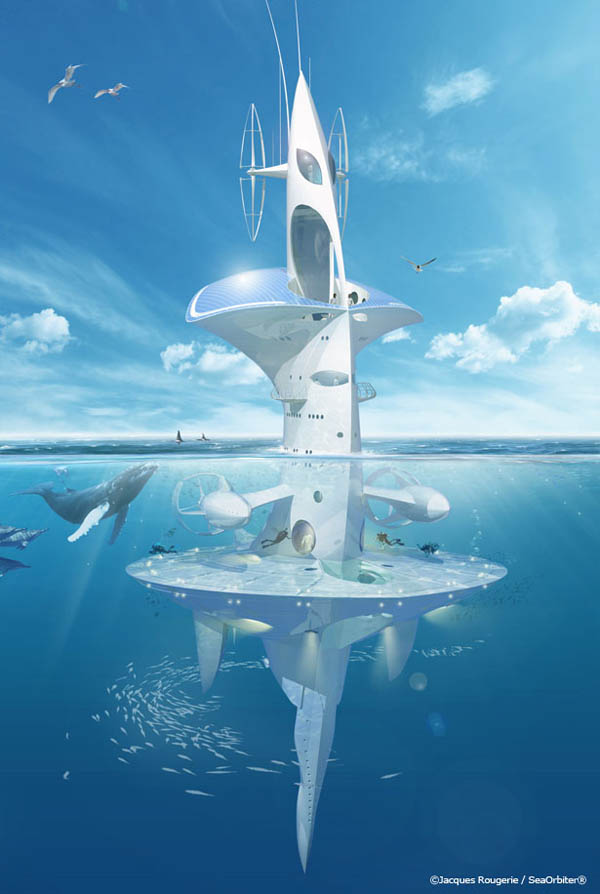
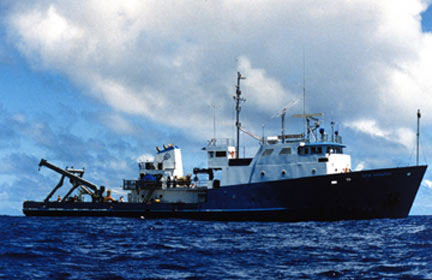
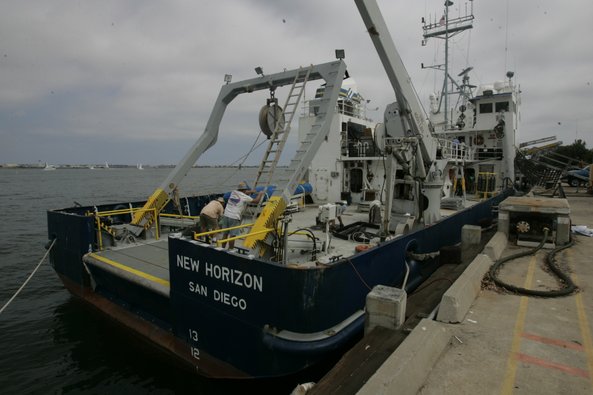
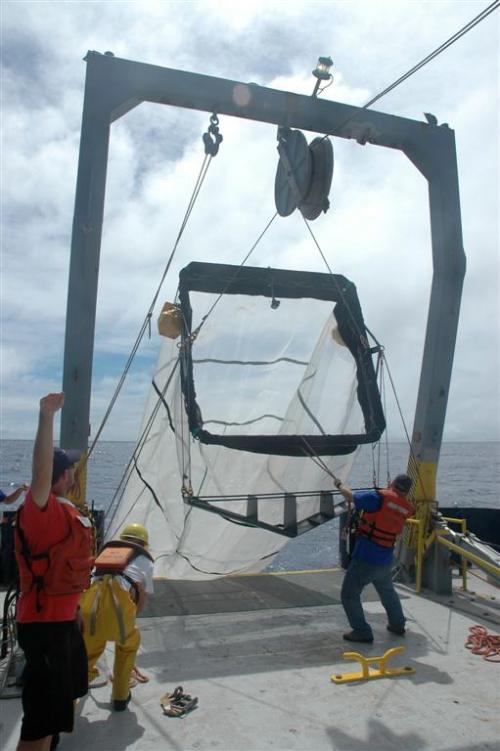
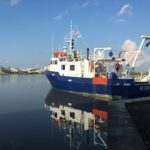




On top of the windage, those puny thrusters have to move a huge displacement hull. Good luck. I call boondoggle.
Heck, yeah — this would absolutely be fun to be aboard! However, for all of your reasons laid out above, I agree that it’s a pretty marginally useful platform for any traditional marine science (and as a pelagic fishes guy, i doubt that even mahi would stick around long enough for anything interesting). My question would be: who’s funding this? I can think of LOTS of other oceanic science that could be accomplished with a $52 million competitive RFP…
You can learn more about SeaOrbiter on Facebook @SeaOrbiter by Jacques Rougerie
I checked out your Facebook page but it does not have detailed information, just links to media and renderings.
I have no idea who is funding it – their website lists the logos of both public (e.g., IUCN) and private (e.g., Microsoft) organizations as “partners,” but there’s no explanation that I could find. And good point re: mahi – I was just trying to think of…something…that’s big and likes to hang out by floating objects. Maybe SeaOrbiter will be a pilot fish research station instead? :)
I will say that the third image on linked page through the image shows a submersible/large ROV below the vessel and the 6th picture shows a large moon pool (I think) in the front of the submerged hull. Unless that just an observation window.
Hey Crankypants,
What’s your problem??? Can’t you see the value of being able to stare into the blue void for months? Plus you would have the opportunity to study a huge fouling community that develops on this wonderful invasive species transport device and fish attractor!
jeez,
Dr. SpongeBob
Oh, nice catch, that does look like a moon pool to me too. Though without a winch or crane it’s pretty hard to lower anything through it.
At least my PhD will qualify me to be an official SeaOrbiter Underwater Window Scrubber?
Fine, but please use a synthetic sponge.
The more I read the website, the more I’m skeptical…the French comes across just as hyperbolic as the English.
Also worth checking out the guy’s architectural website: http://www.rougerie.com/1.html
If you REALLY loved the ocean you’d volunteer.
When I saw this illustration it had a number of characteristics shared in illustrations of hypothetical extraterrestrial creatures by Wayne Douglas Barlowe.
http://waynebarlowe.wordpress.com/artwork/expedition/
The ship’s design looks much like a modified “great strider” with many of the ships appendages looking like biological counterparts on Barlow’s many creatures….
Definite boondoggle. But great post!
Great insight — I had the same flash! Barlow is an astonishing conceptual artist who made his bones as a scientific illustrator:
“While in college he apprenticed in the Exhibition Department of The American Museum of Natural History. During this period Barlowe collaborated with his parents on his first professional book assignment, the Instant Nature Guide to Insects (Grossett & Dunlop).”
— http://waynebarlowe.wordpress.com/biograph/
I’d love to see Syd Mead’s take on a free-floating marine-science station:
http://sydmead.com
Julia Martin, an architectural student in Austria, has some neat ideas and a wonderful enthusiasm for deep-sea design:
http://www.3d-dreaming.com/2012/04/liquidlabs-diploma-thesis-by-julia.html
http://www.facebook.com/UnderwaterNerd
It all looks like the kind of sketch that belongs on Inhabitat.
As long as we’re imagining the blue future, why not a Phoenix 1000 luxury submarine?
http://www.ussubmarines.com/submarines/phoenix_1000.php3
From the folks who behind Triton Submarines (http://tritonsubs.com/) and who are (supposedly) bringing us the Poseidon Undersea Resort (http://www.poseidonresorts.com/poseidon_main.html) came Captain Nemo’s New Ride! To my informed but untrained eye such a sub in a research vessel configuration could really contribute to marine science. (Plus it would be booked fuller than the Hubble Space Telescope!)
Hello, Long time lurker, first time commentor,
I concur, whole-heartedly, about the many restrictions that oceanography places on equipment and vessels.
Rather than go with something like the Enterprise, has there been any research conducted to create actual submarines for ocean studies? Perhaps a larger successor to the NR-1? I have had many thoughts and doodles (most involve a lock-out chamber for submersibles/ROVs/winched equipment/Diving Hard Suits) but perhaps you may have heard more inklings?
Great site btw!
I’m just a marine engineer, and only spent twenty years at sea, but I have to say you wouldn’t catch me dead on that thing. Wait till the sea builds up a bit and I’ll wager that thing will get torn apart. Even in a normal sea state it’ll be pitching like a circus ride ( the ” Vomitorium”). The only thing worse than a naval architect that hasn’t been to sea (and that’s a lot of them) is an land architect that thinks he can build a ship.
Wouldn’t it be interesting to model this thing though. My guess it would be pretty exciting driving it in the wind.
One issue is how will they build and launch the thing? How would it be dry docked when it needs repairs? (It will need repairs eventually.) It just seems like the processes of managing the ship would be more expensive than building it.
Wouldn’t cheaper equipment and vessels targeted toward the research to be done be less expensive than this futuristic ship?
How many post-docs could be supported for how long with $50m?